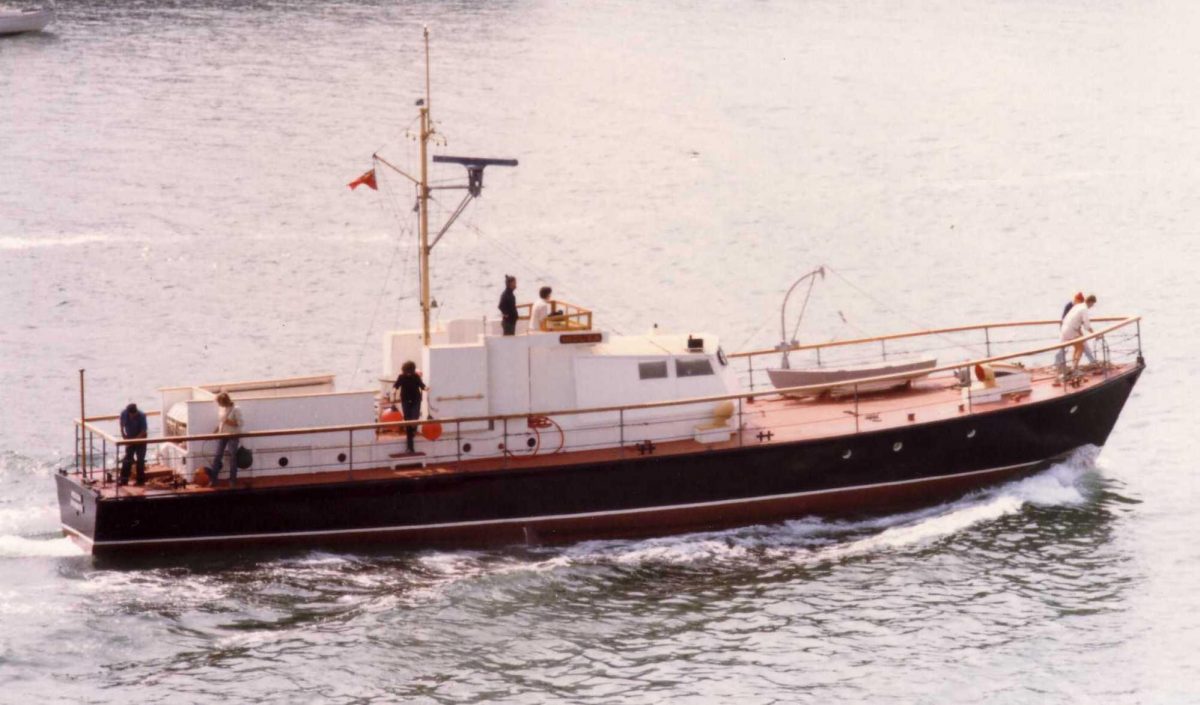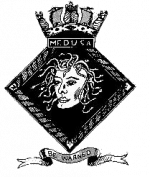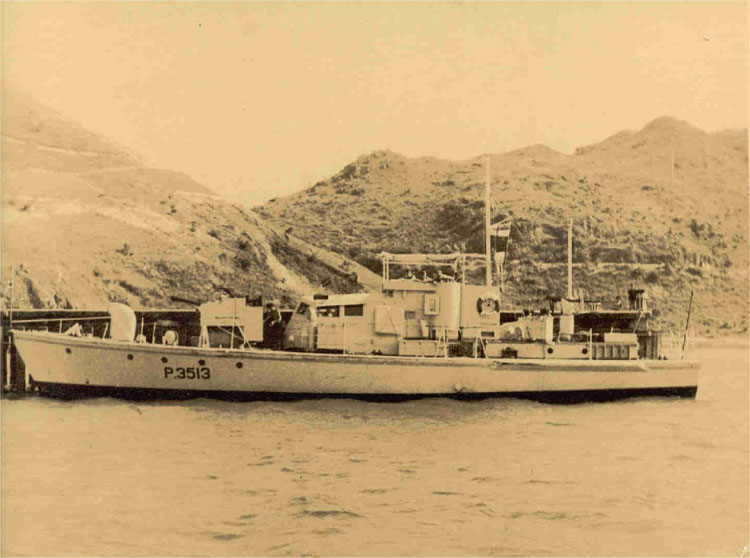HDML 1387
R A Newman, Hamworthy, Dorset 29/12/43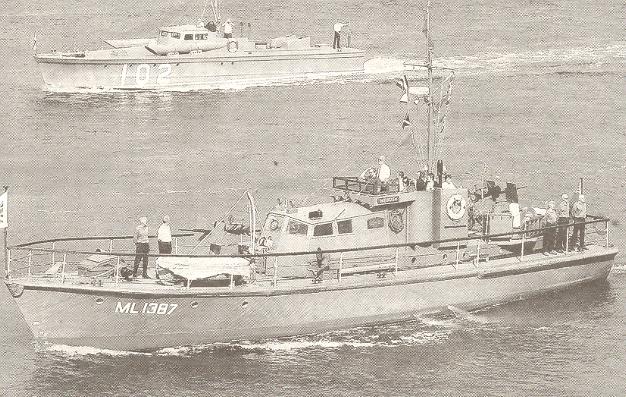
ML 1387 leading the Parade of Historic Craft out of Portsmouth on 5th June 2004
London Gazette 19/12/44 – For good service distributing instructions in the assault anchorage after the first landings in Normandy- MID TSLt Arthur Maurice Liddiard RNVR
- MID LSea Charles George Edwards LT/JX222800
- MID LSea William Victor Walpole LT/JX219689
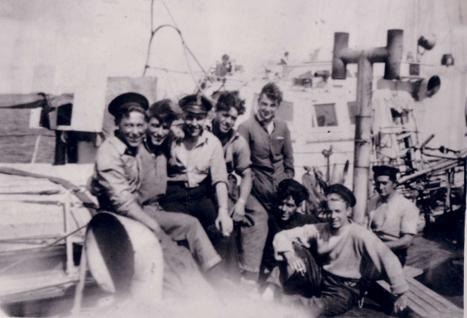 Known Crew
Known Crew
- Wartime
- TSLt Arthur Maurice Liddiard RNVR TASLt HDML 1140 28/5/43 TSLt 22/7/43 149th ML Flotilla Commanding Officer HDML 1387 20/12/43 For good service distributing instructions in the assault anchorage after the first landings in Normandy MID 1944 TLt 1/2/45
- TSLt F R Peter Cox RNVR TASLt 27/8/43 149th ML Flotilla First Lieutenant HDML 1387 19/12/43 TSLt 27/2/44
- LSea Charles George Edwards LT/JX222800 149th ML Flotilla HDML 1387 Birthday Honours 1945 MID
- LSea William Victor Walpole LT/JX219689 149th ML Flotilla HDML 1387 Wind up of the war in Europe MID
- AB Harry Andrew 149th ML Flotilla HDML 1387 (From Grimsby)
- AB Kenneth Lilley 149th ML Flotilla HDML 1387 (From Nottingham)
- AB Douglas Allan Withey 149th ML Flotilla HDML 1387 (From Liverpool)
- AB Dolan 149th ML Flotilla HDML 1387 (Glaswegian)
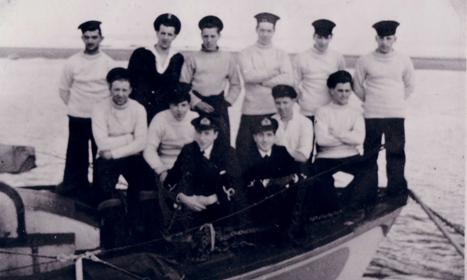 Post War
Post War
- Wartime Activities
- 27/7/43 Laid down
- 20/10/43 Launched
- 29/12/43 Commissioned Based on HMS Hornet 6/12/43 – 6/3/44 HDML (Foreign Service) Pool based at Poole 2/1/44 – 29/1/44 At Portsmouth 30/1/44 – 6/2/44 Caught in a storm off Pembrokeshire whilst escorting a convoy on her way to working up in the Clyde. Piloted into Milford Haven by the coxswain who was a local fisherman.
- 13/2/44 At Ardrishaig
- 20/2/44 On passage to Falmouth Fitting out at Falmouth 27/2/44 – 15/4/44 149th ML Flotilla Based on HMS Forte 6/4/44 – 1/9/44
- 20/4/44 On passage to Portsmouth
- 27/4/44 Departed Portsmouth for Plymouth Part of Task Force O with HDML 1383 and 11th ML Flotilla Operation Fabius I – Practice assault by Task Force O at Slapton Sands, Devon. Operational orders indicated expected attacks by German aircraft, surface craft and submarines. Part of escort force protecting Force O during the exercise. Force consists of 9 USN Destroyers, 2 USN Destroyer Escorts, 6 RN Destroyers, 10 USN PCs, 9 Frigates, 3 Trawlers plus the following Coastal Forces vessels ML 118, ML 153, ML 163, ML 187, ML 189, ML 190 ML 191, ML 194, ML 214, ML 230, ML 304, ML 907 HDML 1387, HDML 1409 Grey Fox, Grey Shark, Grey Seal, Grey Owl
- 27/5/44 Departed Plymouth for Portland
- 6/44 Operation Neptune Invasion of Normandy 149th ML Flotilla ML1295, ML1309, ML1383, ML1387, ML1389, ML1391, ML1392, ML1393, ML1407, ML1409, ML1421. ML1422
- 5-6/6/44 Channel Marker for Omaha Beach on D Day (Beacon position 50 05N 000 46 44W)
From the Operational Orders for D Day…
HDML 1383 and HDML 1387 are identified as the Channel Identification Group. They are to proceed from Portland independantly in time to reach Approach Channels 3 and 4 respectively by H Hour – 13. The approaches are marked by FH 830 acoustic beacons previously laid by ML 147, ML 151 and ML 198 Operation Enthrone HDML 1383 and HDML 1387 are to transmit 3 or 4 as appropriate at 30 second intervals on a shielded blue signal lamp through the night. By day they are to fly a large international code numeral flag. HDML 1383 and HDML 1387 are to remain on station until 2300 on D Day. Distributing instructions in the assault anchorage after the first landings in Normandy
- 18/6/44 Transferred to Portsmouth Command Returned to Portsmouth for convoy escort duties. On completion of escorting a convoy to the blockship harbour at Courseulles (Juno Beach) in bad weather, attempted to put to sea to avoid the drifting barges and other craft but holed the Asdic dome on a rock in the western entrance. Reached Portsmouth for drydocking with both power and hand pumps being used to keep her afloat. Repaired and returned to convoy escort duties
- 2/7/44 HDML 1383 and HDML 1387 at Falmouth. Based on HMS Hornet 2/9/44 – 30/11/44 Detached duty at Granton (Edinburgh) 1/10/44 – 3/12/44
- 3/12/44 On passage to Sheerness Based on HMS Wildfire (Sheerness) 1/12/44 – 31/8/45 Acted as escort for 185th Auxilliary Minesweeping Flotilla based on the Medway. Escorted two water barges from Southend Pier to Ostend and then patroled to Scheveningen, Holland and on to Ijmuiden which was still occupied by German forces waiting to surrender. HDML 1387 accepts the surrender of German forces in Ijmuiden. An armed sentry, in best uniform is placed to patrol the jetty but he trips over a warp and drops the boat’s only rifle into the harbour. HDMl 1387 takes a party of senior officers up the North Sea Canal to Amsterdam as part of the surrender process. Negotiated a sunken blockship by sending the boat away, with AB Harry Andew embarked, to take soundings around the wreck to find a channel and was the first allied vessel to enter the city. Returned to Ijmuiden and then took passage to Rosyth.
- Based on HMS Marshall Soult 1/9/45 – 29/1/46
- 10/45 Refitted at William Osborne’s yard at Littlehampton, Sussex Redesignated as a Fast Despatch Boat (FDB 76)
- 2/46 Delivered to Cardiff University Naval Division as last act of wartime crew
- 2/47 Transferred to Severn Division RNVR Unit
- 8/49 Transferred to London Division RNVR Unit as HMS Thames Redesignated as a Seaward Defence Motor Launch (SDML 3516)
- 11/50 Prepared for transfer to Iran but the transfer was delayed.
- 4/52 Temporarily allocated to the Hydrographic Department and attached to the Survey Training Unit at Chatham.
- 4/53 Transfer to Iran cancelled. Allocation to the Hydrographic Department made permanent
- 1956-57 Independent surveys of the west coast of the United Kingdom
- 1958-60 Independent surveys of the East Coast
- 3/59 Collided, in fog off Ramsgate, with the Dutch coaster Jan Brons (480 tons) and out of action for three months
- 21/3/60 Completed three month refit in Chatham and transferred to Plymouth to work between Torbay and the Solway Firth
- 1961 Named HMS Medusa A 353
- 30/11/65 Paid off for disposal at Devonport. Fire broke out in the messdeck, caused by a carelessly discarded cigarette, and caused significant damage.
- ML 1387 moored in Weston Mill Lake, Devonport.
- 1968 Privately owned as Medusa and moved to Portland. In the first four years as a motor yacht, made 36 crossings of the English Channel.
- 12/02/70 Iranian destroyer Artemiz (ex HMS Sluys) dragged her anchors during a gale in Portland Harbour and collided with Medusa. One of the destroyer’s anchors fouled Medusa’s anchor chain and in freeing it Medusa was cast loose. Medusa was within 100 feet of the rocky shore when the crew boarded her, started the engines and steered her out of trouble.
- 1972 Restoration started. Extensive repairs to the hull were made and the superstructure was rebuilt. Medusa eventually made voyages to Amsterdam, Rotterdam and Brussels.
- 30-31/7/77 Chartered for a military exercise. Transported SAS Reserve and Territorial Army troops to Worbarrow Bay for a night assault.
- 9/80 Chartered by the BBC for the series ’Private Schultz’
- 10/85 Handed over to Gosport Borough Council to become part of the proposed Coastal Forces Museum. The Gannet Society became responsible for maintenance and further restoration. Medusa was berthed on the trials pier belonging to Vosper Thornycroft.
- 7/91 Chartered by the BBC for an episode of ‘Lovejoy’ to enact a burial at sea.
- 1991 Vosper Thornycroft relinquished their lease on the pier and Medusa eventually found a new home in Gunwharf Creek, Portsmouth.
- 20/10/93 On the 50th annivesary of her launch, Medusa visited her builder’s yard in Poole, which was by then owned by Dean & Dyball the construction company. Maurice Lyddiard, her wartime Commanding Officer, took the passage from Portsmouth to Poole. On arrival at Poole Bar, the boat was boarded by a civic party including the Mayor of Poole (Admiral of the port) and the mayoress. The mayor took the helm for a time. This was the first, but not the last time, that the boat flew the flag of the Admiral of the Port of Poole. The Mayor cut the 50th Anniversary cake and a Medusa crest was swapped for a Poole Dolphin.
- 1994 (With Fantasia ex HDML 1410) Attended the D Day 50th Anniversary Commemorations. Acted as escort for HMY Britannia for passage from Netley to Portsmouth.
- 6/6/94 Present at both Omaha and Juno Beaches where the crew held short remembrance ceremonies
- 1995 With Gunwharf sold, Medusa moved to Number 1 Basin in Portsmouth Naval Base, moored alongside Minerva (M33), a World War One Monitor, also being restored.
- 8/97 Became training tender to the Southampton Unit of the Maritime Volunteer Society.
- 2003 Core list vessel in National Historic Ships Register. Operated by the Medusa Trust and based in Southampton
- 2010 Completed a four year refit, largely sponsored by the National Lottery Heritage Fund, conducted at Hythe.
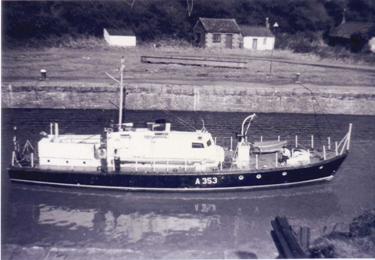
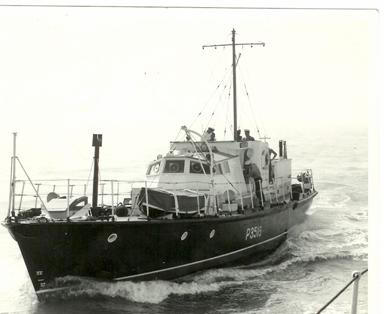
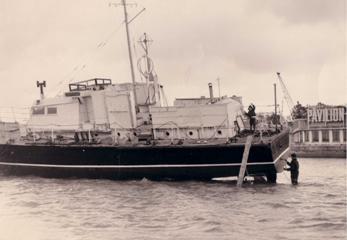 Special Equipment Fitted for D Day
GEE System – Vessel was provided with an RF #27 unit capable of receiving special frequency (XF) transmissions from the Southern GEE Chain. Coding schedules were supplied separately at a late date. Special fine lattice charts covering the assault area were also provided sealed. They were not to be opened before receipt of code message “OPEN ONWEST/O”.
DECCA System – Vessel was provided with Type QM gear. This system was not encrypted. Special fine lattice charts covering the assault area were also provided sealed. They were not to be opened before receipt of code message “OPEN ONWEST/O”.
Radio Beacon 78T – To be switched on when the beacon position was reached and transmitted on 340 degs True. These transmissions were to continue until H Hour (13 hours being the approximate battery life of the device). Type 78T transmissions could be picked up by Radar Types 286 and 291 fitted to some approaching units at 15 miles (if within the beam) or at less than 4 miles (outside the beam). Receivers were tuned to 214 Mega cycles producing a display of a string of needle like pulses giving a code letter at approximate one minute intervals. HDML 1387 transmitted the letter “D”.
Acoustic Beacons used on D Day
FH-830 Acoustic Beacon – Laid by either ML 147, ML 151 ML 198 in position 50 05N 000 46 44W during Operation Enthrone. Type 134 Asdic could receive the beacon transmissions allowing the boat to be conned into position over the beacon. HDML 1387’s beacon was set on High Tone with a four second repetition rate.
Special Equipment Fitted for D Day
GEE System – Vessel was provided with an RF #27 unit capable of receiving special frequency (XF) transmissions from the Southern GEE Chain. Coding schedules were supplied separately at a late date. Special fine lattice charts covering the assault area were also provided sealed. They were not to be opened before receipt of code message “OPEN ONWEST/O”.
DECCA System – Vessel was provided with Type QM gear. This system was not encrypted. Special fine lattice charts covering the assault area were also provided sealed. They were not to be opened before receipt of code message “OPEN ONWEST/O”.
Radio Beacon 78T – To be switched on when the beacon position was reached and transmitted on 340 degs True. These transmissions were to continue until H Hour (13 hours being the approximate battery life of the device). Type 78T transmissions could be picked up by Radar Types 286 and 291 fitted to some approaching units at 15 miles (if within the beam) or at less than 4 miles (outside the beam). Receivers were tuned to 214 Mega cycles producing a display of a string of needle like pulses giving a code letter at approximate one minute intervals. HDML 1387 transmitted the letter “D”.
Acoustic Beacons used on D Day
FH-830 Acoustic Beacon – Laid by either ML 147, ML 151 ML 198 in position 50 05N 000 46 44W during Operation Enthrone. Type 134 Asdic could receive the beacon transmissions allowing the boat to be conned into position over the beacon. HDML 1387’s beacon was set on High Tone with a four second repetition rate.
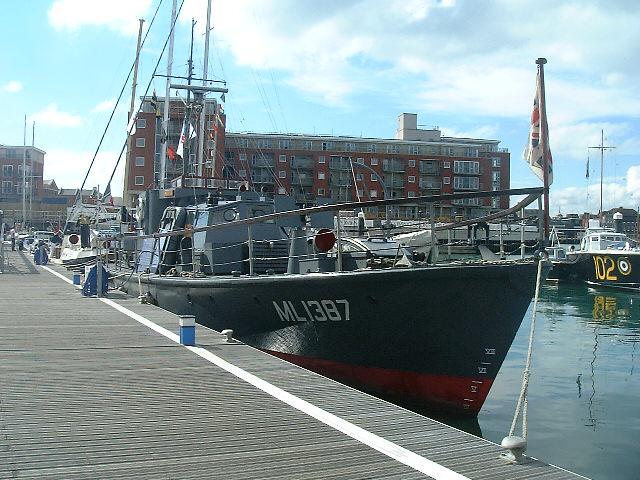
The vessel in 2010 berthed in Gosport
